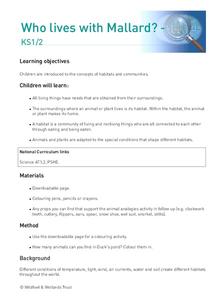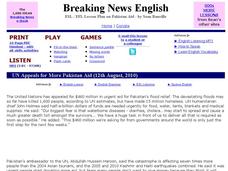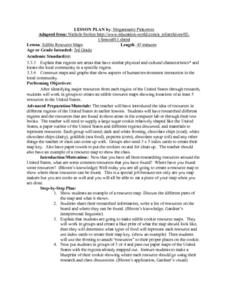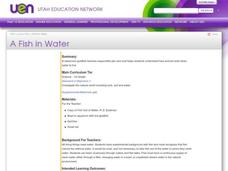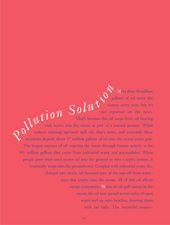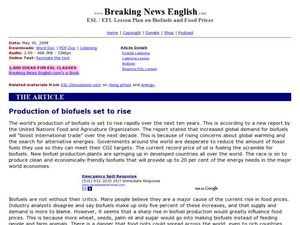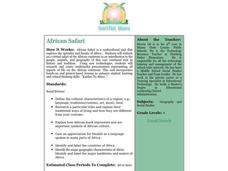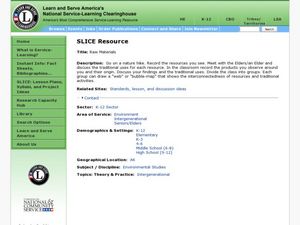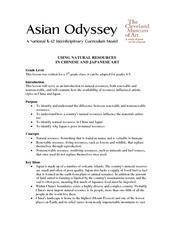Curated OER
Who lives with Mallard?
Students explore how all living things have needs that are obtained from their surroundings. They identify the surroundings where an animal or plant lives is its habitat. Students identify that a habitat is a community of living and...
Curated OER
Jobs and Skills in my Home Worksheet
In this household jobs worksheet, students gather information on jobs in the home and the skills necessary to accomplish those jobs. They also choose a specific topic to research.
Curated OER
Adaptations
Young scholars identify what adaptation is and to research a specific mollusk. They also identify and interpret how animals get their common and scientific name and why it is Latin. Finally, students draw their shell (mollusk) and name...
Curated OER
The Dirt We Depend On- Characteristics of Dirt Reading Comprehension Worksheet
In this reading comprehension worksheet, students read a selection about dirt and soil characteristics. They answer 10 matching questions and 5 multiple choice questions based on the information given in the non-fiction article.
Curated OER
Breaking News English: UN Appeals for More Pakistan Aid
For this ESL comprehension worksheet, students read or listen to the passage, then complete a variety of warm up, before listening/reading, while reading/listening, listening, after reading, homework and discussion activities.
Curated OER
Edible Resource Maps
Third graders work in groups to create an edible resource map showing locations of at least five resources in the United States. Students research on the internet different regions and the resources that are found in those areas. They...
Curated OER
Microbes and Health
Sixth graders become acquainted with the concept of how microorganisms cause disease. They role play that some class members have exhibited some alarming symptoms. Groups must determine which disease the symptoms are pointing to.
Curated OER
Cooking on a Budget
Learners explain if they like expensive or less expensive brands. They choose and eat a complete meal and evaluate themselves on its cost, nutrition and taste.
Curated OER
What Would You Take to Sea? Instructions for Teachers
Students, who are teachers, discover the hazards facing sailors hundreds of years ago as they prepare a activity to use in their classroom. They examine what each group of students will investigate, and how the findings will be discussed.
Curated OER
Prune Boom
Students explore the process of harvesting and canning prunes. They discover the benefits of prunes to the Santa Clara Valley. Students investigate prunes at designated websites.
Curated OER
A Fish in Water
First graders, with a goldfish as a class pet, practice the proper way to care for a pet and have responsibilities when it comes to taking care of the fish. As a class, the teacher reads the book "Fish Out of Water".
Curated OER
THE HUMBLE Beginnings of the Hamburger
Students listen to numerous claims concerning the hamburger's origins and then compose an original tall tale on the subject. Students name some tall tales they have heard or read about. Students make books that feature tall tales...
Curated OER
Life Without Flight
Students keep a journal for an intire week recording their observations of the ways aircraft affect society, The students discuss their findings and categorize them into areas such as military, commercial, research, and so on.
Curated OER
Ecosystems
Third graders identify and define an Ecosystem and the basic needs of all animals. They collect pond water in a pickle jar. They observe the organisms that are in the jar to keep an ongoing record of the creatures and their population.
Curated OER
Pollution Solution
Fourth graders examine how trees help to absorb the pollution that is emitted from automobiles. They review the process of photosynthesis and determine how forest management is important on their reservation. They think about the...
Curated OER
Breaking News English: Production of Biofuels Set to Rise
In this ESL learning exercise, learners read or listen to an article about the production of biofuels. Students complete all or some of the 100 activities available here including discussion, listening, vocabulary and comprehension.
Curated OER
African Safari
Sixth graders gain an appreciation for the different cultures that inhabit the Earth by focusing on the people of Africa
Curated OER
Raw Materials
Students participate in a nature hike and record the natural resources observed. They compare traditional and modern versions of everyday use items, and create graphic organizers that demonstrate the interconnectedness of resources.
Curated OER
It's In the Numbers
High schoolers explore the careers available in the field of oceanography. They discover the difference between a job and a career and the need for a good education. They work together to create a presentation about oceanography.
Curated OER
Using Natural Resources In Chinese And Japanese Art
Students discuss the uses and availability of natural resources in China and Japan and how those resources effected visual art from each country. This instructional activity includes two possible enrichment activities.
Curated OER
A River Mosaic#136
Students determine the meaning of culture as it applies to groups of people. They examine how immigration changes the cultural attribute of a geographic location. They design a Big Book that describes cultural mosaics.
Curated OER
Early Native Americans
Students create a scrapbook illustrating the culture of Native Americans that settled in the Kickapoo Valley. Working in groups, students choose a topic related to the Kickapoo Valley Indians. Using traditional and technological...
Curated OER
Buried in Ice: The Mystery of a Lost Arctic Expedition
Learners read a novel about a lost arctic expedition by Sir John Franklin. In groups, they discuss the author's quest to determine what happened to Franklin and his crew. Using the internet, they compare and contrast the expeditions by...
Curated OER
Breaking News English: Israeli Troops Kill Aid Activists
In this English worksheet, students read "Israeli Troops Kill Aid Activists," and then respond to 1 essay, 47 fill in the blank, 7 short answer, 20 matching, and 10 true or false questions about the selection.
